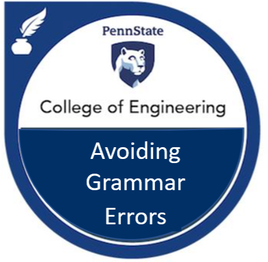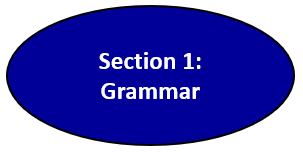Microcredentialing Badge
Avoiding Errors of Grammar, Punctuation, and Usage
Commonly Made in Engineering and Science
|
This site presents a microcredentialing badge that uses assessments, videos, and other resources to help you improve your proficiency in grammar, punctuation, and usage. Two features distinguish the badge: (1) authentic examples from professional documents, and (2) a self-paced organization that allows you to spend time on only the rules with which you are unfamiliar. After completing this material, Penn State students and learners at our partner companies and universities can earn a digital badge. A digital badge is a shareable credential that can help you demonstrate your achievements and competencies on your LinkedIn profile, résumé, or e-portfolio.
The badge, which is formally titled “Avoiding Errors of Grammar, Punctuation, and Usage in Engineering and Science,” will be awarded to students who meet the following criteria:
|
Badges, which are delivered to the email address you provide, will be awarded at the end of each calendar month. For instance, if you complete your badge on June 10, you will receive it by the end of the first business day of July.
|
Acknowledgments
This self-study guide was made possible by funds provided by the Leonhard Center for the Enhancement of Engineering Education in the College of Engineering at Pennsylvania State University. Providing technical assistance on the films is the Office of Digital Learning, which is also in the College of Engineering at Penn State.
This self-study guide was made possible by funds provided by the Leonhard Center for the Enhancement of Engineering Education in the College of Engineering at Pennsylvania State University. Providing technical assistance on the films is the Office of Digital Learning, which is also in the College of Engineering at Penn State.
Role |
Name |
Department |
Institution |
Faculty Editor |
Professor Michael Alley |
College of Engineering |
Penn State |
Film Editor |
Casey Fenton |
Office of Digital Learning |
Penn State |
Film Editor |
Elaine Whitmer |
Office of Digital Learning |
Penn State |
Student Editor, 2022 |
Olivia Brencovich |
Mechanical Engineering |
Penn State |
Website Editor, 2022 |
Marissa Beighley |
Computer Science |
Penn State |
References
- Peg Tyre, "The Writing Revolution," The Atlantic Monthly (October 2012), pp. 99-100.
- Catherine Walker, "Time to Stop Avoiding Grammar Rules," The Guardian (September 2012).
- Tessa Schlesinger, "Why Grammar Matters," Owlcation (7 September 2017).
- Michael Alley, The Craft of Scientific Writing, 4th ed. (New York: Springer, 2018), Appendices A, B, and C.
- Cheryl Glenn and Loretta Gray, The Writer's Harbrace Handbook, 5th ed. (Boston: Cengage Learning, 2012).
- William A. Sabin, The Gregg Reference Manual: A Manual of Style, Grammar, Usage, and Formatting, 11th ed. (New York: McGraw-Hill, 2010).
Please feel free to provide comments, questions, and suggestions for the films, text, and quizzes of this website. To help us understand your feedback, please let us know whether you are a student or faculty member (or other professional).




